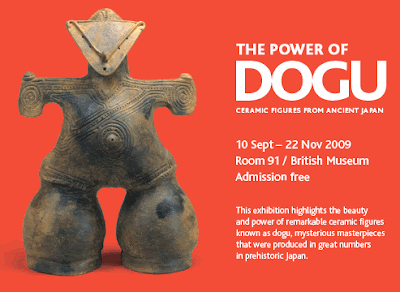. haniwa 埴輪 Haniwa clay figures - Introduction .
:::::::::::::::::::::::::::::::::::::::::::::::::::::::::::::::::::::::::::::::::::::::::::::::::::::
Daruma Pilgrims Gallery
:::::::::::::::::::::::::::::::::::::::::::::::::::::::::::::::::::::::::::::::::::::::::::::::::::::
Dogu Clay Figures (doguu 土偶)


quote
Dogū (土偶, "clay idol / figurine")
are small humanoid and animal figurines made during the late Jōmon period (14,000 BC to 400 BC) of prehistoric Japan. Most of the humanoid figurines have the breasts, small waists, and wide hips of females and are considered by many to be representative of goddesses. Many have the large stomachs associated with pregnancy, suggesting that the Jomon considered them Mother Goddesses. According to the Metropolitan Museum of Art, these figurines "suggest an association with fertility and shamanistic rites". Made from clay, these figurines were never realistic, but, rather, were fashioned into fascinating shapes. The Dogū tend to have large faces, small arms and hands and compact bodies. Some appear to wear goggles or have 'heart-shaped' faces. Most have marks on the face, chest and shoulders, which suggest tattooing and probable incision with bamboo.
Dogū come entirely from the Jōmon period and do not continue to the Yayoi period. As for Jōmon pottery, Dogū has various styles by exhumation area and generation. According to the National Museum of Japanese History, the total number found throughout Japan is approximately 15,000. Most of the Dogū have been found in East Japan and it is rare to find one in West Japan.
The purpose of the Dogū remains unclear but, most likely, the Dogū acted as effigies of people, that manifested some kind of sympathetic magic. For example, it may have been believed that illnesses could be transferred into the Dogū, then destroyed, clearing the illness, or any other misfortune.
Shakōkidogū (遮光器土偶) Shakoki dogu
"shakōki" (literally "light-blocking device")
© More in the WIKIPEDIA !
:::::::::::::::::::::::::::::::::::::::::::::::::::::::::::::::::::::::::::::::::::::::::::::::::::::

The Power of Dogu ...
Ceramic Figures from Ancient Japan
British Museum, Exhibition
September to November 2009
Reference
:::::::::::::::::::::::::::::::::::::::::::::::::::::::::::::::::::::::::::::::::::::::::::::::::::::
Haiku with DOGU
青北風や土偶三千年の黙
aokita ya doguu sanzennen no danmari
northwind out of the blue -
threethousand years of silence
of the clay figures
Yano Tadao 矢野忠男
(aokita is a kigo for autumn, a sudden northwind september and october)
土偶には土偶の使命草の花
doguu ni wa doguu no shimei kusa no hana
the doguu clay figures
have their own mission -
autumn wildflowers
Umeki Sachiko 梅本幸子
お藷蒸す土偶体形疎んずも 高澤良一 寒暑
この秋も会いに無名の土偶の眼 対馬康子 吾亦紅
ひなげしや土偶の乳房に指の跡 大木あまり 火球
みな古き世の色まとふしぐれ土偶 吉野義子
みひらきて秋の翳濃き土偶の目 平井伊都子
五千年も妊みて土偶緑さす 北川英子
人類の旬の土偶のおっぱいよ 池田澄子 たましいの話
優曇華や土偶の顔は皆笑ひ 宮坂静生 青胡桃
凍土もて間牒土偶の鼻こねり 石塚友二 光塵
向日葵は灼けて土偶のおほらかさ 高澤良一 素抱
囀や土偶に逞しき乳房 染谷佳之子
土偶の雛目鼻もわかず笑み給ふ 加倉井秋を
土偶みな掌に乗り土用東風 廣瀬直人「朝の川」
土偶見し眼にたたなはる雲の峯 高澤良一 素抱
山笑ふ土偶のやうに妊婦われ 仙田洋子
日鼻凍む土偶になせり愛しくてか 宮津昭彦
星流れ土偶の眼より波の音 菅野茂甚
春みぞれ土偶は四肢を張りづめに 鍵和田[ゆう]子 飛鳥
春寒く土偶のごとき欠伸して 行方克己 知音
月の出や女体土偶の身籠れる 辻美奈子
根城址にゆかりの土偶秋時雨 苫米地古北
涼しさの火より生れし土偶かな 小池きく江
父に似て母に似て土偶夏痩せぬ 宮坂静生 青胡桃
爽籟や土偶どれにも臍の穴 有馬朗人 知命
秋風に飛出て安き土偶の臍 野澤節子 遠い橋
縄文のみみづく土偶の口寒き 石原八束 『仮幻』以後
縄文土偶の乳房小さし春浅し 近藤一郎
胎の子に手を置く土偶あたたかし 林 ゐづ子
腿太き土偶に割れ目豊の秋 矢島渚男 延年
花冷えや火に洗はれし土偶の肌 野澤節子 遠い橋
芽立ち時土偶のかけらじゃがいもも 尾田秀三郎
菜の花や孕み土偶の深眠り 大森和子
蝉しぐれおーいと縄文土偶の子 岡崎万寿
遮光器土偶がふつと初笑 大森知子
闇のほか土偶は知らず母子草 柴田三津雄
source : HAIKUreikuDB
Tr. Gabi Greve

clay figurine from Gobara, Japan
source : flickr manarh
:::::::::::::::::::::::::::::::::::::::::::::::::::::::::::::::::::::::::::::::::::::::::::::::::::::
. haniwa 埴輪 Haniwa clay figures - Introduction .
:::::::::::::::::::::::::::::::::::::::::::::::::::::::::::::::::::::::::::::::::::::::::::::::::::::::::::::::::::::::::::
Daruma Pilgrims in Japan
O-Fudo Sama Gallery
[ . BACK to DARUMA MUSEUM TOP . ]
[ . BACK to WORLDKIGO . TOP . ]
:::::::::::::::::::::::::::::::::::::::::::::::::::::::::::::::::::::::::::::::::::::::::::::::::::::::::::::::::::::::::::






No comments:
Post a Comment